The best ecommerce personalization strategies have become crucial for re-growth to stay ahead of the competition.
According to a recent Nielsen research report, there were six major consumer behavior thresholds that emerged during the COVID-19 pandemic:
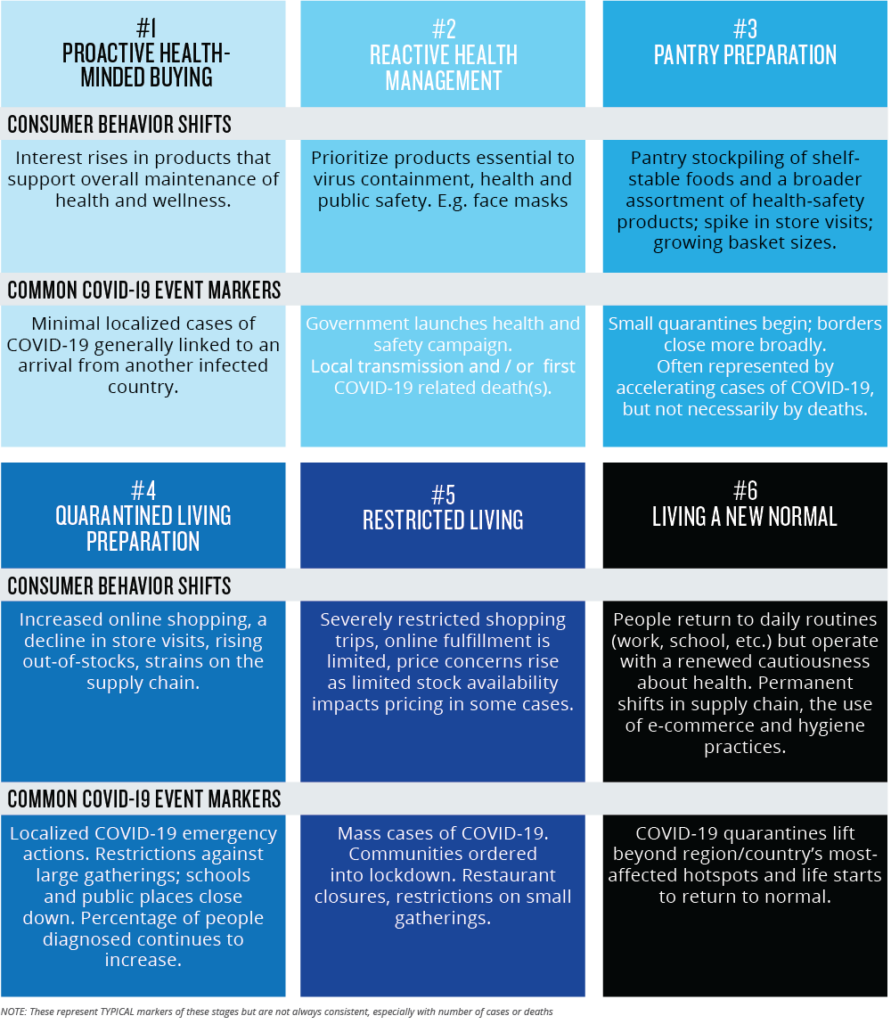
Most of the developed and emerging economies have already gone through the first three levels. Consumer behavior patterns across the next three levels are taking shape as sustained global stay-at-home periods have extended.
Levels 4, 5, and 6 also provide online retailers with an opportunity to respond to new demand signals across demographics. By keeping a pulse on your digital customers’ behaviors – you can personalize the entire customer experience by delivering value at every stage across individual lifecycles.
In this comprehensive guide, we explore the top 8 strategies that are reshaping e-commerce personalization today.
Best Ecommerce Personalization Strategies
To help you effectively re-imagine growth to deliver customer delight at scale with omnichannel personalization – we’ve outlined 8 key action steps that Netcore can help you with:
1. Analyze your customer data to unearth new actionable insights:
As an e-commerce brand, what worked for you initially; is unlikely to shape your future customer and revenue growth engine.
So, double down on gathering and unifying the right customer data. Build and gain a 360-degree view of individual digital customers based on their demographic, geolocation, behavioral, and device-related data points.
Slice-and-dice this data to gather new actionable insights on evolving consumer behavior trends.
You’re likely to uncover higher engagement and conversion rates from customer segments that previously scored low on RFM (Recency, Frequency, and Monetary Value) parameters.
Segments open up new avenues to increase CLTV and retention in the long run through an AI-led omnichannel personalization strategy.
2. Identify new buyer personas:
Fact 1: The COVID-19 crisis has reshaped buyer personas that respond differently when the situation begins to normalize.
Fact 2: Based on the current value chain, your customers will travel through the following phases toward retention:

After analyzing millions of customer behavioral data points, we’ve identified five key buyer personas that will drive demand:
- The Captive Buyer: This type of buyer is reluctant to substitute one product or ecommerce platform with another due to the high cost – in terms of time, effort, and/or money – involved in switching. They don’t mind postponing purchase based on product availability, last-mile delivery capability, ease, and familiarity of platform usage, etc.
- The Hoarder or Panic Buyer: This buyer’s demand is not dictated by price but by the primal emotion of fear. They are likely to purchase products in bulk – primarily “essentials” such as groceries, healthcare and hygiene items. To save customers time and effort, offering the most relevant product recommendations is crucial.
- The Price-Conscious Buyer: This buyer prioritizes product price over platform loyalty or overall customer experience. They will be more attracted to product bundles, offers, and discounts that appeal to their spending propensity.
- The Hesitant Buyer: This buyer begins with the intention of making a purchase but is highly likely to postpone or abandon transactions completely during checkout. You need to give them the confidence in your platform, customer experience, and last-mile delivery. An omnichannel marketing approach orchestrating customer journeys to nudge them toward purchase completion significantly increases conversions.
- The Impulsive Buyer: This buyer, prone to impulsive decisions at checkout, is ideal for targeting with relevant cross-sell and upsell recommendations. This is going to help you increase your average order value per conversion.
3. Personalize the navigational flow across your website or mobile app:
Fact: It doesn’t matter if your ecommerce website has the greatest-looking Home Page or the most visually pleasing app UI/UX anymore. You need to do more. Showing the same site or app to first-time and repeat customers no longer works; each customer is unique.
Leverage your customer’s browsing behavior and order history to customize how you want them to navigate across your website. The more customized your navigational journey, the higher the chances of you directing them towards a purchase – faster.
Experiment with dynamic website elements like graphics, banners, and CTAs to optimize persona-based viewing and navigation.
For instance: You can personalize the Home Page viewing and navigation flow across your e-commerce platform depending on whether a new visitor (or an unregistered app user) or a repeat registered customer lands on your website or launches your mobile app.
4. Strategically leverage AI-driven live product recommendations:
Fact: When your customers are active on your website or mobile app, you need to shorten their paths to conversion by giving them product recommendations that are tailor-made to each one of them. And, if you have a large product catalog, then you need AI to do all the heavy lifting in real-time.
Our AI engine, Raman, displays relevant product recommendations on your Home Page, Product Display Page, and Product Listing Page.
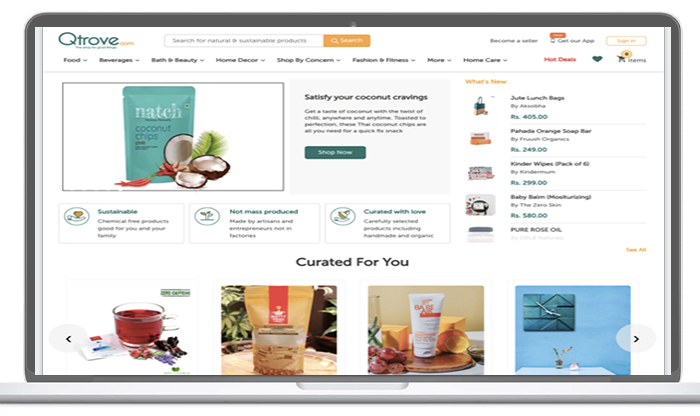
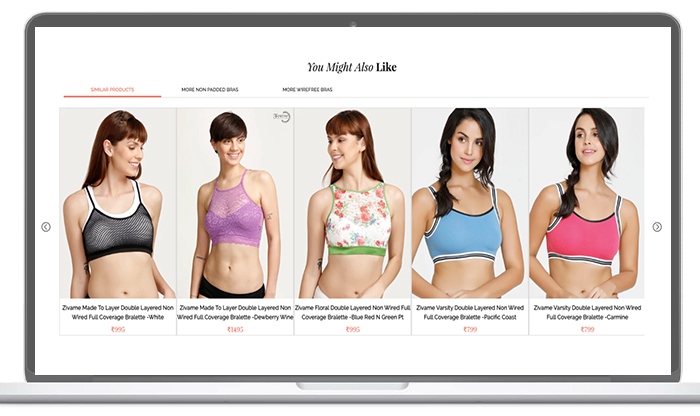
Reorder product categories dynamically based on search behavior, purchase intent, and past orders, ensuring buyers find desired items faster.
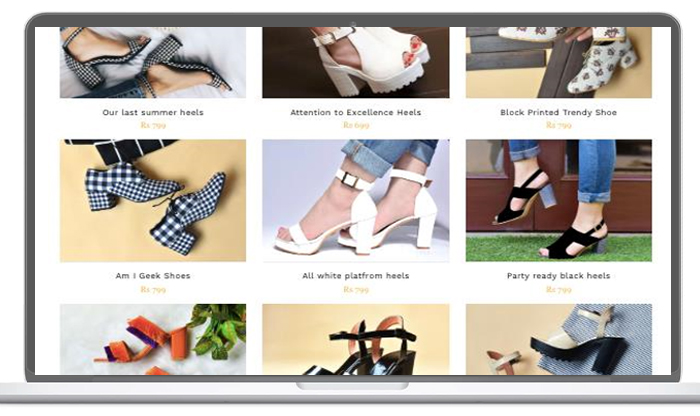
For instance: To better cater to your new buyer personas and customer segments, you need to deploy AI algorithms that learn from their actions and inactions in real-time to deliver contextual product recommendations on your website or mobile app.
The AI engine intuitively learns and predicts with high accuracy what users will likely click, add to cart, and purchase.
5. Curate a personalized virtual storefront:
Fact: Directing your customers to what they want has to be a relentless pursuit as part of your larger personalization strategy.
You can climb higher up the personalization mountain by creating a virtual storefront for individual customers. This should include product recommendations with the highest purchase probability and dynamically update based on customer engagement data.
This curated product list auto-refreshes, accounting for effective recommendations based on time spent hovering over items by customers. These time-stamped signals loop back into our AI engine, making it smarter with every interaction that a customer has with your platform.
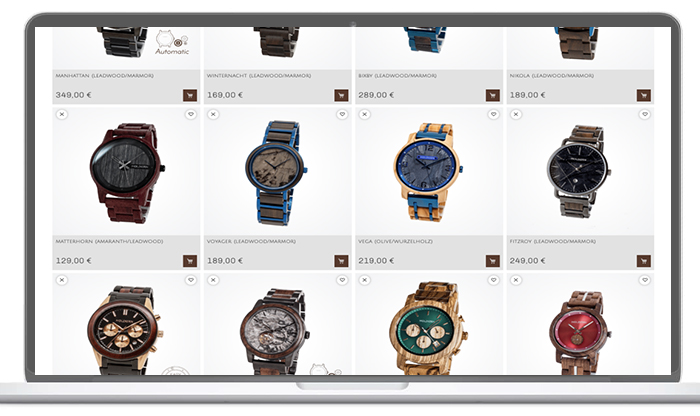
6. Deliver predictive product recommendations across channels:
Fact: Your AI-led personalization strategy has to extend across multiple channels and devices, even when your customer is inactive on your e-commerce website or mobile app. Well-timed 1:1 customer engagement across digital touchpoints increases the probability of conversions – exponentially.
With Netcore, you can now trigger laser-focused product recommendations across high-impact channels such as email, app push notifications, and web messages.
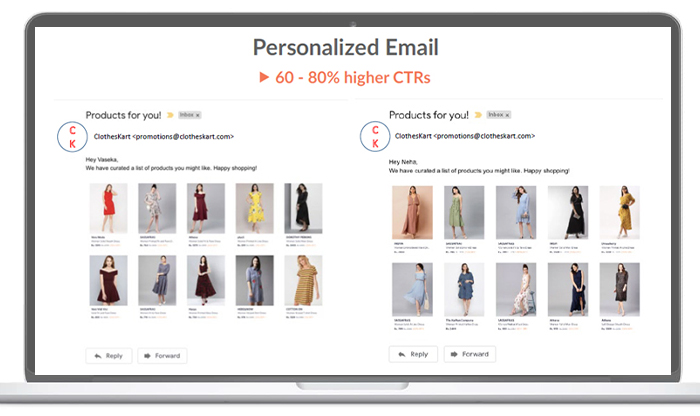
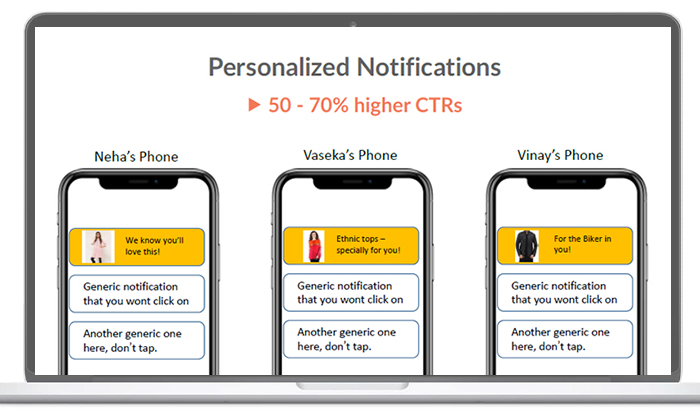
Here are the kind of contextual recommendations that you can deliver to pursue conversions beyond just your website or mobile app:
- “Suggested for You” Recommendations: These recommendations are the best for individual customers, tailored based on their historical behavior like views, cart additions, and purchases.
- “Cart Abandonment” Recommendations: These are generated based on the products added to individual customers’ digital shopping carts where the customer may have dropped off or not completed a purchase
- Buying Pattern Recommendations: These are generated based on individual customers’ most recent product purchases
For instance: If you identify a customer segment that has repeatedly purchased Instant Noodles within the Dry Grocery category and is out of stock due to a demand surge – you can trigger personalized email recommendations updating this segment when the product is back in stock
- Viewing Pattern Recommendations: These are triggered based on individual customers’ most recent products or product categories viewed
- Bestselling Recommendations: These are generated based on the highest-selling products on your website or mobile app. These are products that are being purchased the most when compared to other products over a period of time
- Trending Recommendations: These are generated based on the most trending products on your website or mobile app. Essentially, these are products whose consumption has shown a percentage increase over a period of time.
For instance: Health safety and hygiene products like facemasks rapidly became a trending product within its category and very soon emerged as a bestselling product, when COVID-19 turned into a pandemic.
- Recently Viewed Recommendations: These are generated based on the most common products that have been recently viewed by individual customers on your platform
- “New Arrival” Recommendations: These are generated based on the new products that have been added to your product catalog. Our AI engine maps these products to the ones that are most relevant to individual customers and hits upon the ideal recommendations, capable of nudging them toward an eventual purchase.
Depending upon what channels of customer engagement are working best for which customer segments, you can optimize your multi-channel mix as well as the send-times for these campaigns.
Your recommendations have to be personalized and also need to be delivered on the right channel and at the right time. And our AI engine facilitates all of this.
7. Harness AI-led product recommendations to manage your inventory effectively:
Fact: Your marketing efforts and inventory management have to go hand-in-hand to increase consumption while driving down overhead costs associated with surplus inventory.
The COVID-19 situation has fuelled greater demand for certain products while eroding demand for other items in your product catalog.
So, don’t just rely on “Bestselling” or “Trending” product recommendations to drive conversions. Also account for other products – similar or otherwise – that you can suggest to ease the pressure on your built-up inventory.
Incentivize purchases with attractive discounts, offers, and combo deals. It’s a subtle balancing act and operational trade-off, but an aspect of your marketing strategy that requires urgent attention.
8. Deliver the best possible end-to-end customer experience:
Fact: Customer satisfaction is a function of delivering seamless, reliable, and consistent customer experiences over a long period of time.
While AI-led product recommendations will open up relevance-backed conversion opportunities across customer segments and buyer personas, you still need to get other elements of your value chain just right, such as:
- Seamless website or mobile app UI/UX
- Fool-proof virtual payment gateways and flexible modes of payment
- Sturdy packaging
- Reliable in-time last-mile delivery
- Provision for new-age package collection; eg: contactless delivery
The new rules of e-commerce marketing are already in play. However, a relentless focus on providing a holistic customer experience, especially when supported by the best ecommerce personalization strategies, can significantly tilt these new rules in your favor.
Tackling the New Normal…With AI as your Ally
Incorporating omnichannel personalization, one of the best ecommerce personalization strategies, can significantly propel your brand’s user and revenue growth.
While customer data and AI will enable you to fulfill latent demand, tap into new conversion opportunities, and turn newly identified focus customer segments into loyalists – don’t be a hard-sell!
At such a time, you need to position yourself as a situation-aware, empathetic, and customer-centric brand. And, not come across as a tone-deaf, opportunistic, and ROI-focused brand.
To truly scale your marketing efforts, consider leveraging a robust ecommerce marketing platform. Book a demo today to discover how it can transform your business.
Want to learn how you can harness the power of AI to increase conversions by 8 – 13%? Get in touch with our growth experts, today!







